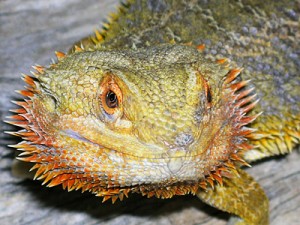Bearded Dragons & Impactation
March 5, 2013 by admin
Filed under Bearded Dragon Info
 Primarily, a number of deaths of bearded dragons are associated with impaction. What impaction? When bearded dragons suffer from impaction, the pet becomes immobile meaning parts of its body or even the whole is suffering from paralysis. Provided that the pet is suffering from a high impaction particularly in the area of the digestive track, all of its legs could suffer from paralysis. On the contrary if the impaction is not as intense, only the back legs of the pet could suffer from paralysis. Provided that bearded dragons are suffering from impaction this means that a particular mass whether it’d be fully solid or not is blocking the digestive tract. In this case, since impaction proves to be a very unpleasant condition for bearded dragons, it would only be logical to examine and enumerate its causes in order to prevent its occurrence.
Primarily, a number of deaths of bearded dragons are associated with impaction. What impaction? When bearded dragons suffer from impaction, the pet becomes immobile meaning parts of its body or even the whole is suffering from paralysis. Provided that the pet is suffering from a high impaction particularly in the area of the digestive track, all of its legs could suffer from paralysis. On the contrary if the impaction is not as intense, only the back legs of the pet could suffer from paralysis. Provided that bearded dragons are suffering from impaction this means that a particular mass whether it’d be fully solid or not is blocking the digestive tract. In this case, since impaction proves to be a very unpleasant condition for bearded dragons, it would only be logical to examine and enumerate its causes in order to prevent its occurrence.
Causes of impaction Read more
Types Of Bearded Dragons
March 5, 2013 by admin
Filed under Bearded Dragon Info
 Bearded dragons are definitely unique in their own right. At first, they may seem scary but at the same time, one will find that they are interesting as they may appear. Emerging from different parts of the globe, they are somewhat adorable despite the fact that they may look intimidating. They differ in appearance, the way the live, and in all other aspects. With these differences, there are several types of bearded dragons that fit every animal lover, breeders, hobbyists and the like. These types will be carefully explained below.
Bearded dragons are definitely unique in their own right. At first, they may seem scary but at the same time, one will find that they are interesting as they may appear. Emerging from different parts of the globe, they are somewhat adorable despite the fact that they may look intimidating. They differ in appearance, the way the live, and in all other aspects. With these differences, there are several types of bearded dragons that fit every animal lover, breeders, hobbyists and the like. These types will be carefully explained below.
The first type would be the Coastal Bearded Dragon. This can be usually located in the eastern and southern parts of Australia and in contrast to the other breeds of bearded dragons; this type is not often preferred by pet enthusiasts. The coastal bearded dragon looks very dull in color and relatively dark. Inland dragons are rather chosen because they are easier to tame compared to the coastal ones, and they are also larger in terms of size. Spots can rarely be found on the neck area of coastal dragons. Among all other types, the coastal bearded dragon appears to have a very strong physical structure, higher resistance to temperature change, including coldness and high levels of moisture in the environment. Read more
Bearded Dragon Lifespan
March 5, 2013 by admin
Filed under Bearded Dragon Info
There are a variety of ways that you can do to lengthen the bearded dragon lifespan. By following the right care and strategy, your bearded dragon pet can live longer yet healthy. The captive bearded dragons are healthier than those wild-caught bearded dragons. They can live longer if their owner is able to give them the proper care for them to survive.
Generally, a bearded dragon can live from 7 up to 10 years as their average lifespan. Some “beardie” species can actually reach up to 12 years to live. It is believed that breeding females have shorter lifespan than the males due to the stress that they experience with reproduction. That is why many breeders have stopped using some of the female animals to breed after 3 or 4 seasons to avoid them from stress that can cause death. Read more
Bearded Dragon Facts
March 5, 2013 by admin
Filed under Bearded Dragon Info
People nowadays are getting more interested in getting a bearded dragon to be one of their pets but people should also have some knowledge about the bearded dragon facts which is significant for breeding and giving proper care to this reptile.
In this article, you can find bearded dragon facts that will make you aware of how to give a healthy and proper care to a bearded dragon lizard.
Originated in Australia, the bearded dragon lizards come with six to seven species of Australian dragons. The Pogona vitticeps (Amphibolurus vitticeps) is considered as the primary species of all the Australian dragon species. All bearded dragons that have been bred in captivity from Germany were exported to the US. Read more
Examining Bearded Dragon Behavior
March 5, 2013 by admin
Filed under Bearded Dragon Info
Bearded dragon behavior is important to take note of since it greatly affects the considerations that you have to make once you have a bearded dragon as a pet. There are several general observations associated with the bearded dragon that we know. Studying the behavior of bearded dragons would help you learn what conditions and factors would be better for your pet bearded dragon and which setups would be detrimental to your pet bearded dragon. The following observations and information regarding the behavior of bearded dragons would be discussed. Bearded dragon behavior, when compared to that of other lizards, is generally very tame and easy going. Bearded dragons make great pets. Read more
Understanding Bearded Dragon Brumation
March 4, 2013 by admin
Filed under Bearded Dragon Info
 Some first time owners of bearded dragons have surely experienced being scared due to their pets’ excessive sleeping- so much that you thought they were dead. Aside from the fact that you always see them resting a lot, they also stop eating and have an infrequent bowel movement. In short, they are lethargic.
Some first time owners of bearded dragons have surely experienced being scared due to their pets’ excessive sleeping- so much that you thought they were dead. Aside from the fact that you always see them resting a lot, they also stop eating and have an infrequent bowel movement. In short, they are lethargic.
Stop worrying because it is just normal; in fact, it’s a part of their life cycle. In this case, your pet is undergoing a bearded dragon brumation.
Bearded dragon brumation refers to the semi-hibernation state that these reptile pets undergo during the winter months, that is common among reptiles. During the winter season, the reptiles adapt to the changing temperature by being dormant for thermoregulation. These animals usually find places for them to insulate and adjust to the temperature that is called hibernaculums. Rocks, burrows and even the water are examples of hibernaculum found in nature. Read more


